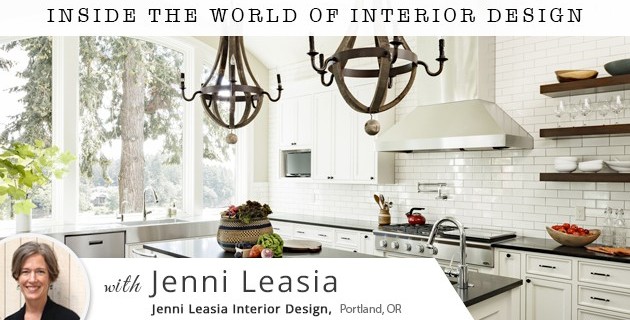My guest for today is acclaimed Portland interior designer Jenni Leasia. From starting off as a television producer to becoming a sought after interior designer in the Portland area, we will hear about her, her design journey, and her design aesthetic.
She is the principal designer at Jenni Leasia Design, which provides personalized interior design services for residential remodels, custom home finishes, and home furnishings. With her design mantra of clean, fresh, and timeless interiors, Jenni offers clients creative design solutions reflective of their personality, and excellent project management. Jenni Leasia Design embraces technology to communicate design concepts precisely and maximize efficiency. Located in Portland, her studio provides services throughout the Pacific Northwest and nationally.
Please welcome Jenni Leasia!
Q: Can you explain a bit about how you found your calling in interior design?
Jenni: In my early twenties, I was a television producer for a PBS show showcasing antiques and collections. I had the opportunity to travel across the country and visit historic homes and tour private and public collections with passionate and deeply knowledgeable curators and collectors. It was an immersive education.
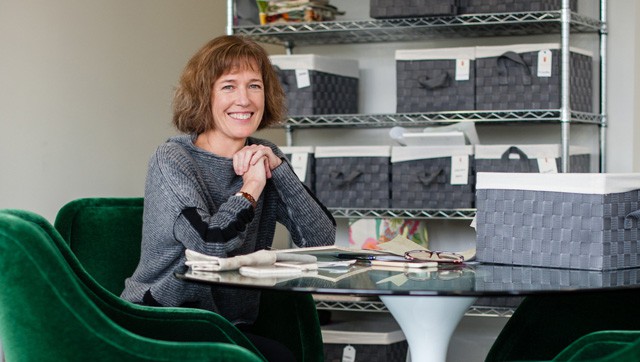
A few years later, my husband and I bought our third house in four years planning to stay in this one to raise our family. The house had great bones, but it needed work. The kitchen had mauve-tone whitewashed oak cabinets and a funky glassed-in addition built on top of a deck. It sounds like I am making it up, but I remember it had an orange and brown plaid pattern vinyl floor. Lots of not suitable stuff for a late 20s cottage style house. We couldn’t afford to remodel, so I decided to spruce it up with new paint, maybe countertops, anything to make it look better until we could really afford to remodel. That plan lasted a couple of weeks. Once I started looking at it, it became clear the cost of making it look better wasn’t worth it if I would still be stuck with the layout. We needed to change the floor plan to make a functioning space that would work for us. I was a not-so-enthusiastic cook at the time, but I knew how to cook and loved to entertain.
I interviewed some designers, and when they told me what they would do, I remember thinking, “I want to do that!” So I started working on the floor plan. I stayed up late at night sketching and re-sketching, playing with the space. I came up with a plan, and we remodeled our kitchen. I was so eager to get going I remember tearing out the lathe and plaster ceiling one night when my kids were in bed, and my husband was at a meeting. I wish I had a video of that mountain of dust and debris pouring down on me.
A couple of things happened. First, the new kitchen made all the difference in the world in how I used the kitchen. I became a better cook once I had a good kitchen. It was much easier in a space that worked the way I wanted to work, and I saw the connection between design and everyday experience in a very immediate way. Second, the mom of one of Charlotte’s classmates (a neighbor) was building a custom home, and she asked if I would be her designer.
I smiled politely, thinking she was just trying to compliment me. “I love your kitchen! I want you to be my designer!” When she brought up it up a second or third time, I realized she might mean it, and I agreed. I had no education, barely any experience, and no experience working for anyone other than myself. When I look back on it now, and it was about 16 or 17 years ago, I think many happy circumstances came together in that project. The “clients” who became dear friends, were lovely people who wanted to make it work. The builder I realize now had the patience of a saint. It was a really fun, collaborative effort on a great custom project. I was waking up super early every morning completely energized by the process, and I realized I had found my calling.
I started a business then and there and went back to school to take design classes and started taking on small projects.
Q: I am drawn to your kitchen designs. The attention to details is fantastic- most noticeable to me in the backsplashes and hoods! Tell me about your approach to designing kitchens.
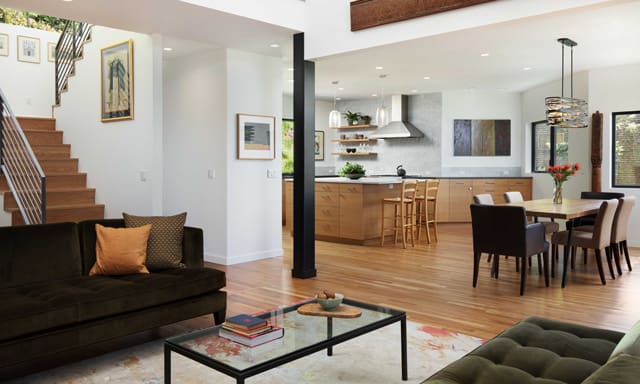
Jenni: We start with the client. Who is using this space? Names, ages, activities? Do you cook? What kind of cooking do you do? Entertaining? What is going to happen in this space every day, and on special occasions? Our needs change over time, and we want to design for the moment, but also be forward thinking to see how the space will accommodate the family as kids grow up and out. While we are taking the client in, and learning about what they need and want in the space, we look at the house. Ideally, the architecture gives us style guidelines, and we want to use them so that our design is in keeping with the original architecture. I don’t mean historically accurate or traditional necessarily, but in keeping. We go for clean, fresh, and timeless. We don’t want our work to read, “remodel from 2019.”
As we work out the floor plan, we begin developing the finishes: stone, tile, lighting, flooring, etc. There are so many beautiful, well-made materials out there, and our work is to bring together the finished scheme that resonates with the client aesthetically and serves them practically. That is the killer combination.
Kitchens are fun because we really do live in our kitchens. I am all for open plans that connect the kitchen with the “living” space because the kitchen is living space. It is great for the cook or cleaning crew to be a part of the fun.
Q: When it comes to kitchens, where do you recommend splurging and where can one save?
Jenni: The big splurge that I recommend if the budget allows is to maximize natural light with plenty of windows, thoughtfully located. It is so much nicer to work and relax in a room with lots of natural light.

And since you mention backsplashes and hoods: These are two contained items that can have a huge impact on a kitchen. A beautiful range and hood make a lovely focal point. A custom designed hood sets the tone for the whole kitchen. The backsplash is another opportunity to make a statement by bringing in pattern, texture, and color. As a rule, we do not pile on the decoration, and that allows the more decorative elements to stand out without being overwhelming and tiring!
In the savings department, we recommend being thoughtful about appliances. If you really do cook, then go ahead and invest in a powerful range, but plenty of home cooks do not need all of that heat or the ventilation that goes with it. We almost always specify a tiny microwave (hidden if possible) that costs next to nothing. The other side of this coin is considering how long you plan to be in this space. If this is your long term home, it might make sense to invest in a Subzero. But that is not a good decision if you move every two to three years.
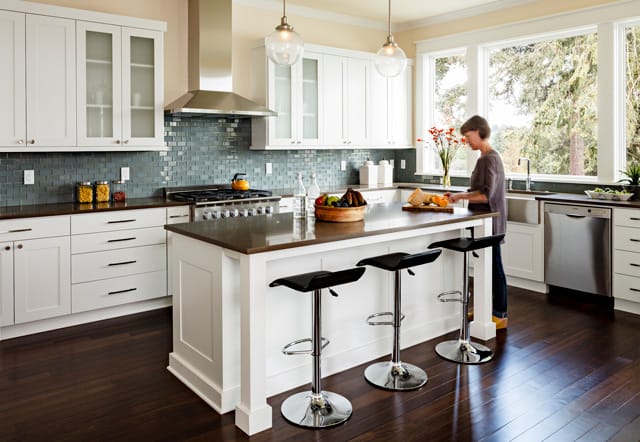
There are opportunities to save with finishes and still maintain a high level of quality. One example is porcelain tile. The style range is seemingly infinite, from clean contemporary to Calacatta marble imitations that look fantastic. It is durable, readily available, and inexpensive.
Q: You share that you bring in a trusted general contractor during the design stage. Why is that? And, what are the benefits to the client of hiring a designer and contractor as a team as opposed to having two independent relationships?
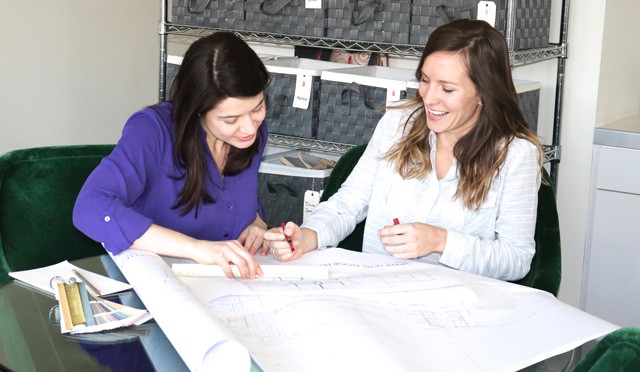
Jenni: We identify the general contractor for almost all of our projects. We work with builders who have the same attitude about client service and satisfaction that we do. It is a given they will bring in excellent subcontractors and produce a high-quality renovation. They will proactively resolve problems that arise—in collaboration with our team. They will maintain excellent costs, necessary changes, and scheduling issues as they arise. The advantage to the client is that we have a relationship with this builder, we have tested them, and we know what they bring to the project, which makes clients more comfortable at the outset. A renovation is a major undertaking, and clients understand the builder is crucial to the success not only in the final product but in the process itself.
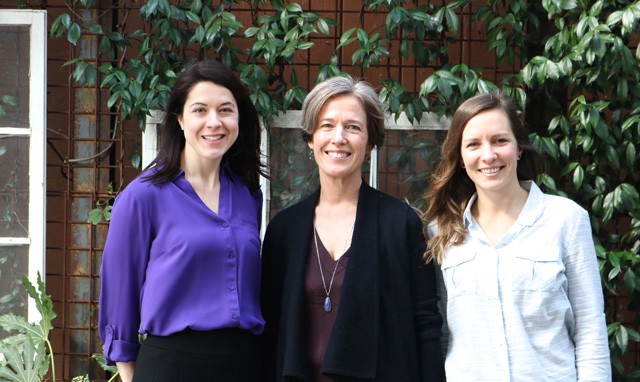
Another advantage for the clients is that we have a working relationship that adds efficiency to the process. We are collaborators from start to finish. Right now we are working on a kitchen in a historic home just south of Portland. We began by considering several different floor plans, and one of them involved relocating the stairs to the basement. I brought our builder to the house before we completed any drawings to consult about the structural issues and make sure there weren’t obstacles that we didn’t recognize. A strong collaborative relationship produces a better project and saves the client money.
Q: Your bathroom designs are lovely. What are the main decisions that go into making a bathroom look and feel as luxurious as a high-end spa?
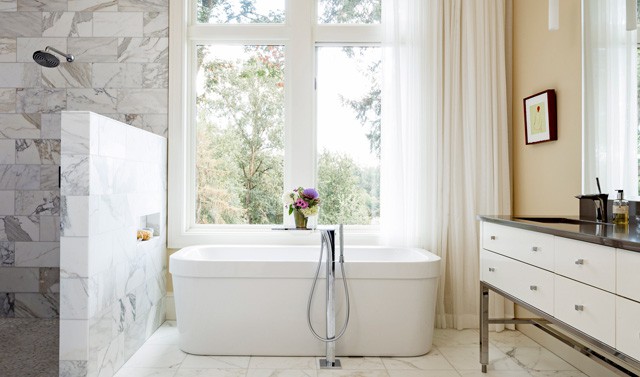
Jenni: One of the reasons we love designing kitchens and bathrooms so much is that these are spaces we all constantly use, how great to make them something that we can truly enjoy—that is luxury. It begins with a thoughtful and efficient floor plan. Next, invest in beautifully made materials, skillfully installed.
As far as the “extras.” Right now, we are putting steam in a client’s shower, which I think is a great usable luxury. The other element we have been adding recently is smart toilets. We have a client who had always loved using them in Japan, so when we remodeled her bathroom that was one of her must-haves.
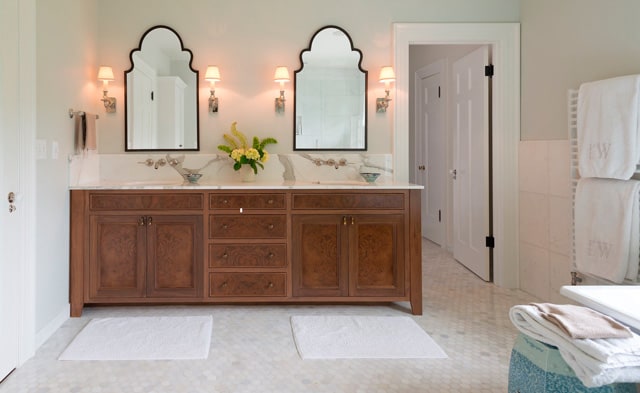
Here is my luxury bathroom design tip for all bathrooms: Incorporate enough storage space to put everything away! I love photographs of minimal bathrooms with floating vanities—virtually nothing in sight. But if they are covered with jars, bottles and other bath stuff in “real” life, the design isn’t working very well.
Q: What is unique about being a Portland interior designer? Does Portland, Oregon, and the Pacific Northwest have different home styles, different interior design trends, or different climatic considerations?
Jenni: We love many things about working in the Pacific Northwest. Maybe first and foremost right now is that we have a very active “maker” economy. There are furniture makers, fabric designers, and amazing tile manufacturers, to name a few. We have many opportunities to bring a custom local touch to our projects.
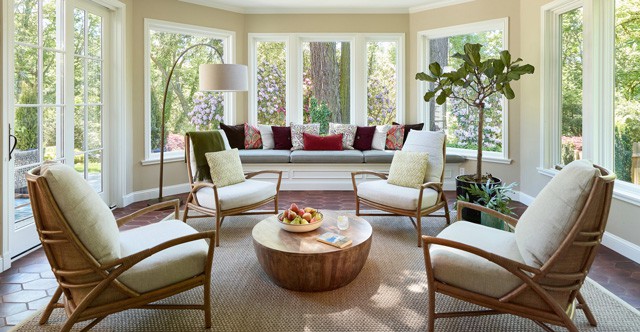
As far as design elements that characterize the Pacific Northwest style, we use a lot of wood, stone, and other natural materials. We are always thinking about the connection between the interior and the outdoors and work to maximize natural light since we are starved for light about half of the year.
Typically, our clients, whether it’s a mid-century modern or a Colonial Revival, will want every room to be luxurious and informal. “Luxurious” here means beautifully made and meticulously planned for their lifestyle and aesthetic. That is our definition of a luxury home.
Q: Your studio apparently has found a lot of benefit in embracing technologies for designing and managing your projects. What software do you use, and how does it benefit your clients and the final results?
Jenni: I have heard designers say, “Interior design is 5% creative and 95% project management.” I think it is hard for anyone to understand how much information there is to manage in every successful project. Technology is useful for that kind of data recording, tracking, and retrieval. Every efficiency that we add to the process benefits the client by helping to get the job done correctly and on time. Obviously, that creates cost savings for the client, and it keeps us from losing our minds! It’s a win-win!
On a daily basis, we use Asana, IvyMark, My Hours, Dropbox Paper, and Vectorworks. Asana is a project/task management platform, Ivy is a design project purchasing and invoicing software, we track time in My Hours, and Dropbox Paper is a platform we use to share images, links, drawings and tons of other project related information with clients, vendors, builders, and subcontractors. They can comment and give feedback, and all of the communication is documented and updated for everyone. (It’s kind of like google docs, but we like it better.) Vectorworks is our CAD software.
Thank you so much for taking the time out to talk to me. This interview has not only been very insightful but also such a pleasure, and my readers are sure to benefit from your sharing. I look forward to seeing your future projects.

